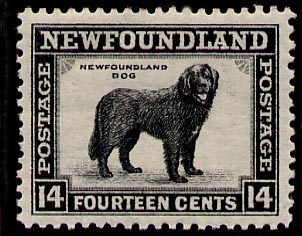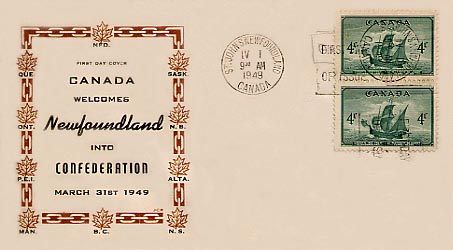
History

 |
Newfoundland History |
 |
Newfoundland History
Newfoundland Joins Canada (1946-1949)
Newfoundland and Confederation (1949)
[This text was publihed in 1950. For the full citation, see the end of the document. Parts in brackets [...], links and images have been added to the original text by Claude Bélanger.]
[For a history of the negotiations of Newfoundland with Canada, see this site; Mel Baker also discusses this issue at this address; the specific period of 1945 to 1949 is extensively studied by the same author at this site.] Although Newfoundland had become at least temporarily self-supporting again during the War, the United Kingdom Government decided that consideration of constitutional changes should be delayed until after the close of hostilities. In December, 1945, it announced that a National Convention would be elected by the people of Newfoundland to assist them in coming to a "free and informed decision as to their future form of government".
The Convention was elected in June, 1946, and its 45 members met in the following September. Its terms of reference were:
To consider and discuss amongst themselves as elected representatives of the Newfoundland people, the changes that have taken place in the financial and economic situation of the Island since 1934 and, bearing in mind the extent to which high revenues of recent years nave been due to wartime conditions, to examine the position of the country and to make recommendations to His Majesty's Government as to possible forms of future government to be put before the people at a national referendum.
In May, 1947, a delegation was sent to London to ascertain what financial relations might be expected to exist between the United Kingdom Government and Newfoundland under (a) continuation of Commission of Government as then constituted, (b) a revised form of the Commission, and (c) responsible government. The reply was that under the first the fiscal and financial relations would remain as then existing and the United Kingdom would continue to be responsible for Newfoundland's financial stability; under the second, the responsibility of the United Kingdom for Newfoundland's financial stability would depend upon the precise form of revision; under responsible government Newfoundland would bear full responsibility for her own finances.
In February, 1947, the National Convention had passed a resolution to send a delegation to Ottawa to ascertain from the Government of Canada "what fair and equitable basis may exist for federal union of Newfoundland and Canada ". A similar resolution to send a delegation to Washington to ascertain the terms on which union with the United States might be effected, was defeated by a large majority.
A delegation of seven members [1] was sent to Ottawa in June, 1947, and discussions with the Committee of the Canadian Cabinet continued into September [2]. On Oct. 29, 1947, the Canadian Prime Minister sent the Governor of Newfoundland for transmission to the National Convention a statement of terms which the Government of Canada would be prepared to recommend to Parliament as a basis for union, should the people of Newfoundland desire to enter Confederation.
After prolonged debate the National Convention recommended to the United Kingdom Government, on Jan. 29, 1948, that two choices be placed before the people, the restoration of Responsible Government and continuation of Commission of Government. A motion to include Confederation on the ballot was defeated in the Convention by a vote of 29 to 16.
The United Kingdom Government, after due consideration, decided to add Confederation to the ballot, having concluded that "it would not be right that the people of Newfoundland should be deprived of an opportunity of considering the issue at the referendum". The official statement pointed to Canada's offer being based on long discussion with a delegation from the Convention, to the support for Confederation shown in the Convention, and to the fact that the issues had been sufficiently clarified to enable the people to decide whether Confederation would commend itself to them.
At the first poll of the National Referendum , held on June 3, 1948, after wide public discussion, 155,777 (more than 88 p.c.) of the 176,297 registered voters went to the polls. Responsible Government received 69,400 votes, Confederation 64,066 and continuation of Commission of Government 22,311 votes. As no form of Government had received an absolute majority, a second poll was required on the two forms receiving the most votes, in-accordance with the conditions previously announced by the United Kingdom Government.
At the second poll on July 22, 1948, approximately 85 p.c. of the voters turned out. Some 78,323 voted for Confederation with Canada and 71,334 for Responsible Government. Eighteen of the 25 electoral districts as established in 1933 showed a clear majority for Confederation.
On July 30, 1948, the Prime Minister of Canada announced that the result of the referendum was "clear and beyond all possibility of misunderstanding", and that it was welcomed by the Government of Canada. He added that the Government would be "glad to receive with the least possible delay authorized representatives of Newfoundland " to negotiate Terms of Union.
Negotiations opened at Ottawa on Oct. 6, 1948. [3] The basic problem was that of including within a matured federal system a country that had developed independently of the other provinces and whose economy and administrative arrangements were very different. As in 1864, and more particularly 1895, the financial aspects of the problem presented the greatest difficulty. On the one hand, Newfoundland could not be expected to enter Confederation unless it received reasonable assurance that it could carry on financially as a province. On the other hand, it was obviously desirable that the financial arrangements for Newfoundland should fit as nearly as possible into the existing framework of financial relations between the Federal Government and the provinces.
The main provisions of the Terms ultimately arrived at were as follows: (1) the Federal Government was to take over Newfoundland services which were at the time normally provided for other provinces, including the government-owned railway; (2) the Federal Government was to assume responsibility for Newfoundland's sterling debt (about $63,000,000 net, or about 90 p.c. of the total); (3) Newfoundland was to retain its surplus which had been accumulated during the war and post-war years; (4) Newfoundland, as was the case with other provinces, was to receive from the Federal Government stated annual subsidies in perpetuity; (5) in addition in order to enable Newfoundland to develop revenue-producing services similar to those of existing provinces, it was to receive annual transitional grants over a period of twelve years, the grants to diminish over the period and cease at its end; (6) the Federal Government was to appoint within eight years of Union a Royal Commission to review Newfoundland's financial position and to recommend the form and scale of additional financial assistance, if any, which might be required by the Government of Newfoundland to enable it to continue public services at then prevailing levels without resorting to taxation more burdensome, having regard to capacity to pay, than that of the Maritime Provinces. The total financial aid thus given Newfoundland was proportionately higher than that given to other provinces at the time they joined Confederation or were created, but it was felt that Newfoundland 's special problems justified somewhat special financial treatment.
On Dec. 11, 1948, the Terms of Union were signed in the Senate Chamber at Ottawa by six of the seven members of the Newfoundland delegation on behalf of Newfoundland and by the Prime Minister and the Acting Secretary of State for External Affairs on behalf of Canada.

A Bill to approve the Terms of Union was passed by the Canadian Parliament and given the assent of the Governor General on Feb. 18, 1949. On Feb. 21, the Commission of Government in Newfoundland announced its approval and shortly afterwards a Bill to confirm and give effect to the Terms of Union was introduced in the British House of Commons. This Bill received Royal Assent on Mar. 23 as the British North America Act, 1949. In accordance with the Terms, Newfoundland joined Canada as its tenth province at midnight on Mar. 31, 1949. [This site documents the various stages of the Union of Newfoundland with Canada.]

On the occasion of Newfoundland's entrance into Confederation, Canada Post
issued a stamp showing the "Matthew", John Cabot's ship.
[1] F. G. Bradley, K.C., Chairman, T. G. W. Ashbourne, Charles H. Ballam, Rev. Lester L. Burry, P. W. Crummey, G. F. Higgins, and J. R. Smallwood
[2] Rt. Hon. Louis S. St. Laurent, K.C., Rt. Hon. J. L. Ilsley, K.C., Rt. Hon. C. D. Howe, Hon. Brooke Claxton, K.C., Hon. D. C. Abbott, K.C., Hon. J. J. McCann, M.C., Hon H. F G. Bridges and Hon. W McL. Robertson.
[3] The Newfoundland delegation was headed by the Hon. A. J. (later Sir Albert) Walsh. Other members were: F. G. Bradley, K.C., C. A. Crosbie, P. Gruchy, C.B.E., J. B. McEvoy, C.B.E., K.C., J. R. Smallwood and G. A. Winter. The Committee of the Canadian Cabinet included: Rt. Hon. Louis S. St. Laurent, K.C., Rt. Hon. C. D. Howe, Hon. Brooke Claxton, K.C., Hon. D. C. Abbott, K.C., Hon. J. J. McCann, M.C., Hon. M. F. Gregg, V.C., Hon. R. W. Mayhew, and Hon. L. B. Pearson.
Source: GOVERNMENT OF CANADA , Newfoundland. An Introduction to Canada's New Province, Published by authority of the Right Honourable C. D. HOWE, Minister of Trade and Commerce, prepared by the Department of External Affairs, in collaboration with the Dominion Bureau of Statistics, Ottawa, 1950, 142p., pp. 15-41.
© 2004 Claude Bélanger, Marianopolis College |